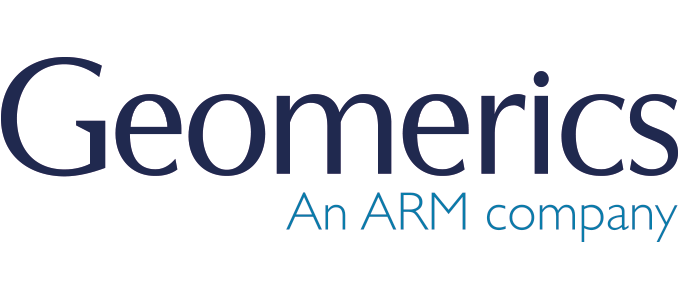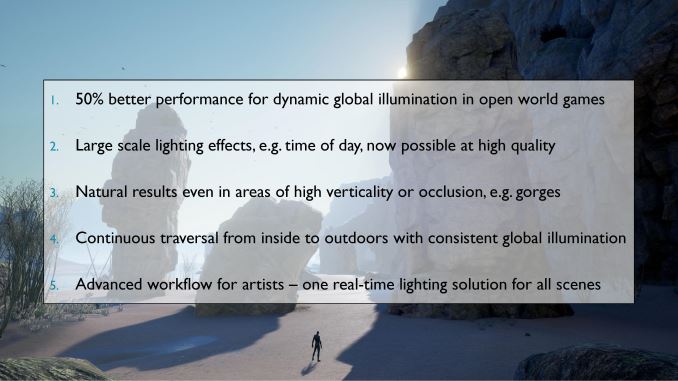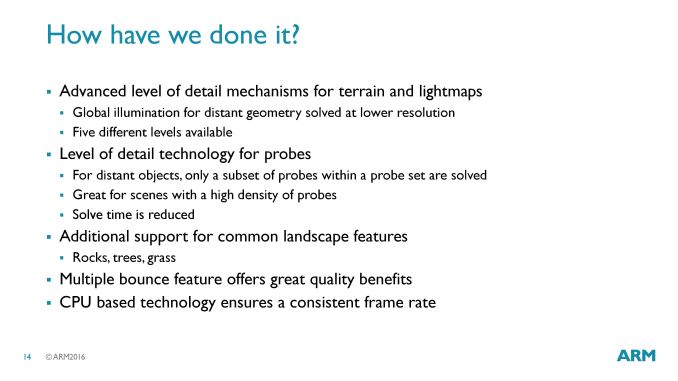GDC 2016: Geomerics Demonstrates Updated Enlighten Lighting Tech
by Ryan Smith on March 15, 2016 12:00 PM EST
As some of our regular readers may already be familiar with them, ARM’s Geomerics division is one of the more unusual parts of ARM’s overall business group. Unlike the hardware IP ARM is best known for, Geomerics is responsible for developing and licensing technology for global illumination and indirect lighting. The group’s flagship product is Enlighten, which to date has seen use in a number of games.
This year Geomerics is at GDC to show off the latest version of Enlighten, and the latest tech demo using it, Seastack Bay. In the last year Geomerics has been focusing on improving Enlighten’s performance and abilities particularly for open world games, which require lighting on larger scales and with new technical challenges such as day/night cycles and indoor/outdoor transitions.
The latest version of Enlighten has in turn been further optimized for these scenarios. Geomerics tells us that overall lighting performance in large open world games has improved by upwards of 50%, and the company has tackled some thorny issues such as efficiently calculating indirect lighting between vertical surfaces. The latest Enlighten also has new features for landscape lighting, e.g. grass and trees.
The key technical change in the latest version is the addition of level of detail support for large terrain lighting. With upwards of 5 different levels, like other LOD implementations Enlighten’s lighting LOD allows for environments to be lit at progressively lower resolutions the farther away the terrain is. This reduces the overall rendering workload by not assigning too much CPU time to small features that are too far away to be seen. This same technology has also been implemented for light probes – specific points in a scene where lighting is calculated – allowing probes to be skipped the farther away they are.
Finally, all of this is in turn being used in the Seastack Bay tech demo being shown off at GDC. Seastack Bay is a 5km x 5km terrain chunk with a 1km beach front, specifically designed to demonstrate the new features of Enlighten. The demo was built in conjunction with Hellblade developer Ninja Theory, and is being demonstrated on both the PC and PlayStation 4.


















8 Comments
View All Comments
nathanddrews - Tuesday, March 15, 2016 - link
So... kind of like NVIDIA PCSS for lighting? Maybe a closer comparison would by VXGI?LawrenceM96 - Tuesday, March 15, 2016 - link
It's real time global illumination. VXGI is one approach to real time global illumination. Enlighten takes a different approach. They are just different methods of achieving real time GI.Mat3 - Tuesday, March 15, 2016 - link
From what I know of Geomerics, the lighting can be dynamic but it requires data to be preprocessed and affects only static geometry. On the other hand, it's sure to run better than Nvidia's VXAO and isn't restricted to only certain Geforces.Trefugl - Tuesday, March 15, 2016 - link
I don't know much about Geomerics, but looking at the attached slides (specifically the 6th one), it reads like it can still handle moving dynamic objects. It just preprocesses the static geometry to speed up the realtime solving. I could be misunderstanding how they are doing it though.nathanddrews - Tuesday, March 15, 2016 - link
Right, I want to identify technologies that do similar things in order to compare them. I wonder what sort of hit this would take on a map size like Witcher 3?SleepyFE - Tuesday, March 15, 2016 - link
From what i understand not much. If it's too far to be seen it isn't processed.Timbrelaine - Wednesday, March 16, 2016 - link
Unity is incorporating Enlighten, so you'll see this everywhere in the next few years.It seems very efficient, but partly that is because it isn't actually realtime GI. Enlighten requires a big chunk of its lighting equation to be pre-computed for the scene geometry, which in turn requires that most of your geometry is static. The dynamic/realtime part doesn't relieve Enlighten of the main limitation of ordinary pre-baked lighting.
It is still a very cool piece of tech and a step in the right direction- true dynamic GI.
Timbrelaine - Wednesday, March 16, 2016 - link
Like pre-baked lighting engines, it can handle dynamic objects but only in a limited way, with limited distances, objects and light sources.